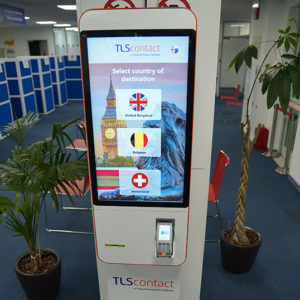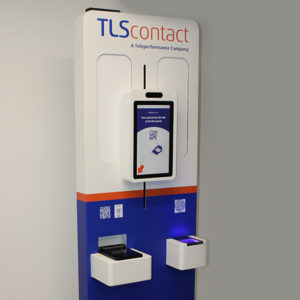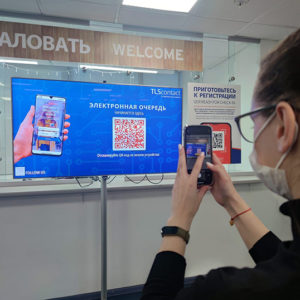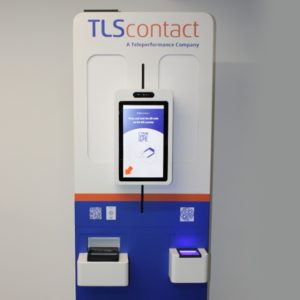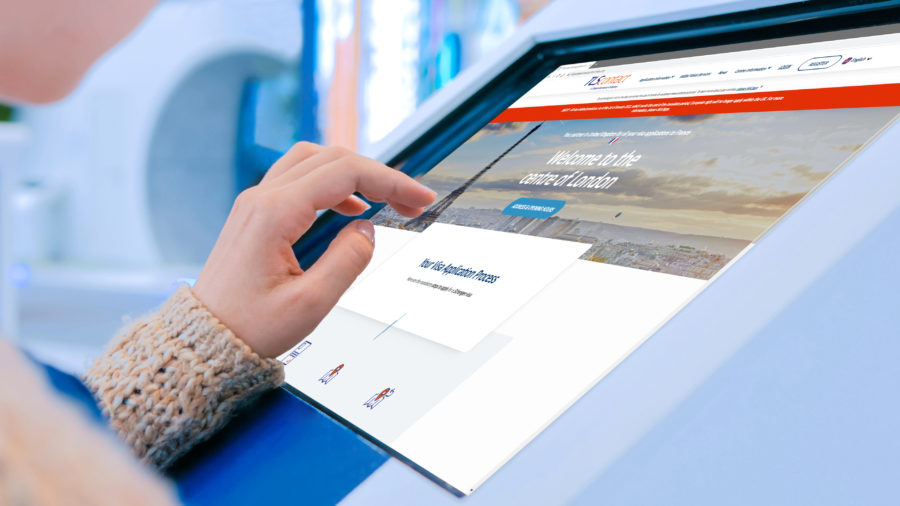
As part of the digital transformation of the visa application process, there is an increasing focus on self-service solutions that could simplify the customer journey. In this article, we explore the ways in which we are harnessing technology to offer different self-service options to our visa customers around the world, improving the visa experience while maintaining the highest levels of security.
Touchscreen technology to select additional services
An idea from our local team in Russia initiated the introduction of new touchscreens in our Russian visa application centres at the end of the summer 2020. Our colleagues had been inspired by the ‘interactive tables’ found in shopping malls and wanted to see how we could use a similar concept to improve customer experience at TLScontact. The modern touchscreens that we have installed in our centres have an attractive, intuitive design, similar to that of a standard smartphone or tablet. They provide information about our range of additional services and allow customers to select the services that interest them and pay for them online in a series of simple steps, before proceeding to document submission and biometric enrolment. Since launch, these screens have improved efficiency and enhanced customer satisfaction at our Russian centres.
Self-service kiosks for biometric enrolment
While mobile enrolment is already possible with today’s technologies, challenges remain when it comes to fingerprint capture, which is still an essential part of biometric enrolment for a visa application. There can be quality issues, in addition to the obvious challenge of binding fingerprints with biographic information to prove a person’s identity. Self-service kiosks can provide at least part of the answer, and are one option currently being considered in the visa sector to provide additional flexibility for customers. They can guarantee high-resolution biometric capture in a secure setting and could be installed in visa application centres themselves. This would allow an applicant to attend one of our centres without making an appointment and carry out a fully self-service process. This would be possible as long as they had previously uploaded their supporting documents using our TLSdocuments self-scanning platform.
Self-service kiosks could also be installed securely in locations such as banks or shopping malls, to increase the options and flexibility available to customers. This would be particularly useful in large countries, where visa applicants might otherwise have to travel a significant distance to their nearest visa application centre.
Read our article Digital transformation of the visa application process.
At TLScontact, we have developed a prototype self-service biometric kiosk, that we recently piloted with a group of users. This provides high-quality fingerprint capture and facial photography. It is also combined with the latest anti-spoofing and liveness detection technologies, or Presentation Attack Detection (PAD) to guard against the risk of fraud. Biometric data files are fully encrypted to ensure secure transfer to government servers.
QR code technology for a touchless experience
Another innovation that we are testing at our Russian centres is QR code technology. Using a QR code on arrival at the centre, customers can carry out a completely touchless process, selecting and purchasing additional services online but also adding themselves to the queue to submit their application in person. If they have already provided their documents through our online self-upload platform, they can proceed directly to the biometric enrolment phase.
Ultimately, if combined with a biometric self-enrolment kiosk, this could offer a fully self-service process to our customers, where they could submit their application, supporting documents and biometrics, and purchase any relevant services, without needing to interact with one of our agents if they did not want to.
While this could work well in certain cultures, we recognise that human interaction is highly valued in others. Our model allows us to tailor solutions to client requirements, efficiency imperatives and available technology. We also take into account cultural considerations, adopting a more nuanced approach to self-service where required to maintain the optimum customer experience.
A high tech, high touch approach
Our aim with these technologies is to provide a faster, more flexible and fully customer-driven process. In the current context where health and safety risks are top of mind, we can offer a safer environment to customers, with less face-to-face contact. These improvements also allow our agents to focus on higher-value tasks and provide more personalised support to those who require it and who might feel less comfortable with a fully digital journey.
While mobile enrolment is not yet a reality for visa applications to many countries, there are still many ways in which we can harness technology to provide more self-service options for those customers who want them. However, in line with our high tech, high touch approach, human interaction will remain an important part of the visa process for many customers. The key is to automate the right processes to allow staff to then focus on the more complex interactions that are still essential to providing excellent customer service.
Article written by Andrei Tjutrin, Technology Product Manager
in association with Tatiana Antseva, Zone Manager Russia
